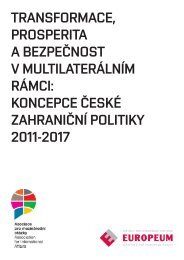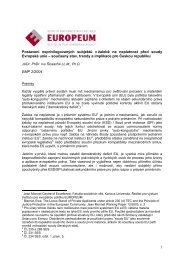eu constitutionalisation - EUROPEUM Institute for European Policy
eu constitutionalisation - EUROPEUM Institute for European Policy
eu constitutionalisation - EUROPEUM Institute for European Policy
Create successful ePaper yourself
Turn your PDF publications into a flip-book with our unique Google optimized e-Paper software.
Chapter 4: Government Coalitions and Institutional Re<strong>for</strong>m at the IGCferences in terms of federalist versus intergovernmentalist visions of the EU(as well as party political difference between both parties in power – Frenchconservative and German socialist), however their views were much moreconvergent on the principles related to the size of countries which wereequally (if not even more) present in the negotiations.Spain and PolandA Spanish-Polish coalition that emerged at the end of the Conventionand continued during the IGC was a novel constellation in EU politics.Spain has been a member since 1986 while Poland only joined the EU inthe May 2004 enlargement. The comparable size of the countries (bothmedium-sized) resulted in the emergence of convergent positions onrepresentation in the EU institutions, and especially on the question of thedistribution of votes and the voting system within the Council of Ministers.The institutional interests were rein<strong>for</strong>ced by some other issues preferredby both conservative governments, such as a reference to Christianity inthe constitutional treaty, close relationships with the US and support <strong>for</strong>the Anglo-American war on Iraq.At the same time, both states aspired to a greater role within EU decisionmaking.⁷¹Under Aznar, Spain was eager to become more ‘respected’ at theEU level. It was interested in pursuing issues which would strengthen itsposition vis-à-vis other <strong>European</strong> states, especially France and Germany.⁷²Poland, as the largest of the new accession countries, had similar aspirations.The Polish were especially sensitive to the balance of power with Germanyand this relationship was part of the national debate on the EU constitution.Being close to national elections, it was especially important <strong>for</strong> the governmentto show the voters that it was able to defend the national interest.The similarities between the two countries helped the Spanish in recruitingPolish into a coalition to defend retaining the Nice <strong>for</strong>mula on the definitionof QMV. It is not surprising that this was a vital issue <strong>for</strong> Spain givenits bargaining behaviour in particular during the 2000 IGC. In Nice, largestates bargained against losing their second Commissioners if a rule of onecommissioner per member state was introduced. Spain had a special inter-71) Confidential interview on 10 September 2004 with a Polish government official.72) Chari, Egea de Haro, Benoit and Laver (2004). Confidential interview on 1 July 2004 with a Spanish governmentofficial.120Chapter 4: Government Coalitions and Institutional Re<strong>for</strong>m at the IGCest in this regard. As it had retained the right <strong>for</strong> the second commissioneras a compensation <strong>for</strong> not being in parity with the four large states in theCouncil following the Amsterdam Protocol, it stoutly demanded compensationin terms of voting weights in the Council. This demand was indeedrealised and the same ‘upgrade’ in terms of votes in the Council of Ministerswas granted also to Poland in view of its potential accession to the EU.Thus when the Convention reopened the discussion on the QMV system,Spain naturally opposed the re<strong>for</strong>m and eventually (towards the end ofConvention) recruited Poland to its cause. In fact, Poland’s initial reactionto the proposal on the change of the Nice <strong>for</strong>mula in the Conventionwas favourable. It was due to Spain’s guidance and arguments on whytheir relative position within the EU decision-making would worsen ifthe Nice <strong>for</strong>mula was changed, that its positions shifted and it <strong>for</strong>meda coalition with Spain.⁷³ There was no common proposal or amendmenton institutional provisions tabled by the both governments <strong>for</strong> most of theConvention negotiations.The signals of disagreement with the new proposed <strong>for</strong>mula on QMV camefrom the Spanish government representative Dastis (also a member of thePraesidium) towards the end of the Convention in May 2003. Dastis managedto rally support from Denmark, Poland, the UK, Sweden, Austria,Ireland, Lithuania and Cyprus <strong>for</strong> the retention of the Nice <strong>for</strong>mula notonly <strong>for</strong> the system of voting in the Council of Ministers, but also <strong>for</strong>the composition of the Commission and the distribution of seats in theParliament.⁷⁴ However, in the end, this support was diluted and Dastisdid not manage to influence the Convention outcome. Both the Spanishand Polish governments expressed their dissatisfaction with the outcomeon the issue of the definition of QMV and announced that they would seekto reopen it during the IGC.⁷⁵While Poland kept a rather low profile during the Convention, it came outmuch more <strong>for</strong>cefully on the issue of QMV system be<strong>for</strong>e the beginning ofthe IGC. During the Convention in 2002 Poland was still undergoing theaccession negotiations and in 2003 it was preparing <strong>for</strong> the EU accession73) Confidential interview with a Polish official in Brussels, 10 September 2004.74) Norman (2003): 2.75) Confidential interview with a Polish official in Brussels, 10 September 2004 and Spanish official in London,1 July 2004.121








